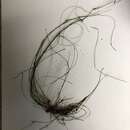Comments
provided by eFloras
Most specimens of Eleocharis vivipara are from Florida. Identification of vegetative (often aquatic) specimens is sometimes tentative. Eleocharis vivipara is often confused with E. microcarpa and E. brittonii, and sometimes with E. baldwinii. The red-spotted band at the sheath apex and the gray, cancellate achenes are characteristic of E. vivipara.
- license
- cc-by-nc-sa-3.0
- copyright
- Missouri Botanical Garden, 4344 Shaw Boulevard, St. Louis, MO, 63110 USA
Description
provided by eFloras
Plants perennial, short-rhizomatous, forming dense clumps, often entirely vegetative; rhizomes caudexlike, ascending, internodes and scales hidden by crowded culms and sheaths, 0.5 mm thick. Culms often arching, often sering as stolons, broadly elliptic, (4–)7–38(–45) cm × (0.1–)0.3–0.7 mm, soft to firm. Leaves: distal leaf sheaths persistent or disintegrating, yellowish to pale brown, sometimes mottled or wholly red-brown, membranaous to papery, apex acute to narrowly obtuse. Spikelets: basal spikelets absent; usually proliferous, ovoid to ellipsoid to linear or terete, 3.3–9.6 × 1.2–2.3 mm, apex acute; proximal scale empty, persistent, amplexicaulous, similar to floral scales (usually slightly longer, midrib broadly green); subproximal scale with a flower; floral scales spiraled, 5–25, 4–8 per mm of rachilla, pale brown, usually spotted, streaked or mottled red-brown to purple, midribs green or green and red-brown, elliptic to obovate, 1.8–2.7 × 1–1.5 mm, membranous to chartaceous (papery), midrib evident to prominent, apex rounded to obtuse. Flowers: perianth bristles 5–6, red-brown (proximally often white), shorter than to equaling tubercle, rarely longer, 0.9–1.3(–2) mm; spinules sparse, retrorse, sharply acute; stamens 3; anthers yellow, 0.8–1.8 mm; styles 3-fid. Achenes gray or greenish, obovoid or obpyriform, trigonous, angles very prominent, 0.6–0.9 × 0.55–0.8 mm, apex constricted proximal to tubercle, finely honeycomb-reticulate at 10–20X, each face with 20 or more rows of evident enlarged cells. Tubercles whitish, gray, brown, or greenish black, pyramidal, trigonous, 0.2–0.5 × 0.4–0.5 mm.
- license
- cc-by-nc-sa-3.0
- copyright
- Missouri Botanical Garden, 4344 Shaw Boulevard, St. Louis, MO, 63110 USA
Distribution
provided by eFloras
Ala., Fla., Ga., La., N.C., S.C., Va.
- license
- cc-by-nc-sa-3.0
- copyright
- Missouri Botanical Garden, 4344 Shaw Boulevard, St. Louis, MO, 63110 USA
Habitat
provided by eFloras
Sandy and peaty soils, ditches, pond margins, shallow waters bordering pine-flatwoods and pine-palmetto scrub; 0–80m.
- license
- cc-by-nc-sa-3.0
- copyright
- Missouri Botanical Garden, 4344 Shaw Boulevard, St. Louis, MO, 63110 USA
Synonym
provided by eFloras
Chlorocharis vivipara (Link) Rikli; Eleocharis curtisii Small
- license
- cc-by-nc-sa-3.0
- copyright
- Missouri Botanical Garden, 4344 Shaw Boulevard, St. Louis, MO, 63110 USA
Comprehensive Description
provided by North American Flora
Eleocharis vivipara Link, Hort. Berol. 1: 283. 1827
Chlorocharis vivipara Rikli, Jahrb. Wiss. Bot. 27 : 564. 1895. Eleocharis Ctirtisii Small, Man. SE. Fl. 165. 1933. (North Carolina.)
Erect from a stout often vertical rootstock covered by the culm-bases of the previous year ; roots coarse, deep brown ; culms 1-3 dm. high, filiform to 0.5 mm. wide, light green, faintly punctate, deeply striate to sulcate ; sheaths yellowish, often purple at the base, firm, acute and frequently lightly purple-tipped at the apex ; spikelets linear-cylindric, acute, manyflowered, 3-8 mm. long, usually wholly proliferous and seldom perfecting fruit; scales appressed, obtuse, 2 mm. long, usually without a keel, dark chestnut on the sides, with whitish hyaline margin, the lowest somewhat larger, erect and appressed to the base of the spikelet ; style trifid ; achene triangular, obovate, 1 mm. long, dark gray, coarsely reticulate to canccllate ; style-base pyramidal, narrower than the achene, light gray to nearly black with a whitened elevated ridge at the base ; bristles reddish-brown, closely retrorse-toothed, nearly equaling the achene.
Type locality : Grown at the Berlin Botanic Garden. Distribution : Swamps on the coastal plain : Virginia to Florida.
- bibliographic citation
- Henry Knut Svenson. 1957. (POALES); (CYPERACEAE); SCIRPEAE (CONTINUATIO). North American flora. vol 18(9). New York Botanical Garden, New York, NY
Eleocharis vivipara: Brief Summary
provided by wikipedia EN
Eleocharis vivipara is a species of flowering plant in the sedge family known by several common names, including umbrella hairgrass, sprouting spikerush, and viviparous spikerush. It is native to the southern United States from eastern Texas to eastern Virginia. It takes the form of a clump of thin stems. A spike of flowers appears at the tip of the stem. The plant may also reproduce by growing a plantlet and runners.
Eleocharis vivipara may grow in the water or on land. When it is aquatic it uses C3 carbon fixation pathways for photosynthesis. When it grows out of the water it switches to the C4 mechanism.
This species grows along the margins of water bodies, such as ponds, marshes, and ditches.
- license
- cc-by-sa-3.0
- copyright
- Wikipedia authors and editors

